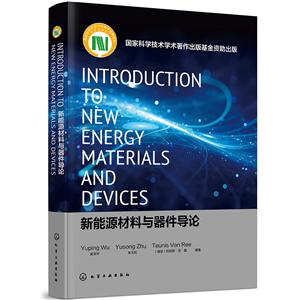-
>
湖南省志(1978-2002)?铁路志
-
>
公路车宝典(ZINN的公路车维修与保养秘籍)
-
>
晶体管电路设计(下)
-
>
无头案:雍正暴亡之谜
-
>
基于个性化设计策略的智能交通系统关键技术
-
>
花样百出:贵州少数民族图案填色
-
>
识木:全球220种木材图鉴
新能源材料与器件导论(英文版)(精) 版权信息
- ISBN:9787122371843
- 条形码:9787122371843 ; 978-7-122-37184-3
- 装帧:一般胶版纸
- 册数:暂无
- 重量:暂无
- 所属分类:>
新能源材料与器件导论(英文版)(精) 内容简介
《Introduction to New Energy Materials and Devices》一书,全面系统地介绍太阳能、氢能、生物质能、核能、动力电池、储能和燃料电池等研究的基础知识和近期新进展。以储能和换能为顺序,先系统介绍了目前电化学储能系统,如锂离子电池、其他新型电池和不错电容器的工作机理、发展历史和近期新进展;接着介绍了常见的换能系统如燃料电池、太阳能电池、太阳能制氢的研究现状和未来趋势;很后简单介绍了生物质能、核能和其他新能源的发展展望。本书深入浅出,每一章均从基础知识讲起,内容涉及材料、物理、化学、电子、机械等多学科,知识体系涉及固体物理、电化学、材料科学与基础、半导体物理与器件、薄膜技术与材料等。接着从基础讲到应用,探讨对应储能换能器件的组装、存在的问题和发展方向。该书既避免枯燥的机理介绍,又能使读者在对储能换能器件的深入了解中加深对机理的了解。 本书采用全英文编写,不仅适合于高等院校与新能源领域相关的本科生、研究生的双语教材或参考书,也适合于相关的科研与管理工作者入门参考之一。
新能源材料与器件导论(英文版)(精) 目录
1.1 Brief introduction to world energy consumption 001
1.2 History of various new energy materials and devices 006
1.2.1 Batteries 006
1.2.2 Supercapacitors 008
1.2.3 Fuel cells 009
1.2.4 Solar cells 010
1.2.5 Biomass energy 012
1.2.6 Nuclear energy 012
1.3 Principles of various new energy materials and devices 013
1.3.1 Principles of metal-ion secondary batteries 013
1.3.2 Principles of other secondary batteries 014
1.3.3 Principles of fuel cells 015
1.3.4 Principles of supercapacitors 017
1.3.5 Principles of solar cells 017
1.3.6 Principles of solar-to-hydrogen 018
1.3.7 Principles of biomass energy 019
1.3.8 Principles of nuclear energy 019
1.4 Some requirements for various new energy materials and devices 020
1.4.1 Requirements for lithium secondary batteries 020
1.4.2 Requirements of other secondary batteries 020
1.4.3 Requirements of fuel cells 022
1.4.4 Requirements of supercapacitors 023
1.4.5 Requirements of solar cells 023
1.4.6 Requirements of solar-to-hydrogen conversion 023
1.4.7 Requirements of biomass energy 024
1.4.8 Requirements of nuclear energy 024
1.5 About this book 024
References 025
Chapter 2 Lithium secondary batteries 028
2.1 Positive electrode materials for LIBs 029
2.1.1 LiCoO2-based positive electrode materials 030
2.1.2 LiNiO2-based positive electrode materials 031
2.1.3 LiMn2O4-based positive electrode materials 032
2.1.4 LiFePO4-based positive electrode materials 034
2.1.5 LiNi1-x-yCoxMnyO2 (NCM) positive electrode materials 034
2.2 Negative electrode materials for LIBs 036
2.2.1 Graphite 036
2.2.2 Si-based materials 038
2.2.3 Titanium oxides 038
2.3 Electrolytes for LIBs 039
2.3.1 Liquid electrolytes 040
2.3.2 Solid electrolytes 043
2.4 Separators for LIBs 045
2.4.1 The functions and characteristics of the separator 045
2.4.2 Separator types 046
2.4.3 Separator preparation methods 047
2.5 Aqueous rechargeable lithium batteries 049
2.5.1 First generation aqueous rechargeable lithium batteries 050
2.5.2 Second generation aqueous rechargeable lithium batteries 051
2.5.3 Third generation aqueous rechargeable lithium batteries 052
2.5.4 Side-reactions with H2O and O2 in an electrolyte 053
2.5.5 Water-in-salt aqueous rechargeable lithium batteries 054
2.6 Li-sulfur batteries 054
2.6.1 Principles of Li-sulfur batteries 055
2.6.2 Sulfur positive electrodes 056
2.6.3 Electrolytes for Li-sulfur batteries 056
2.7 Li-air batteries 057
2.7.1 Water-based lithium-air batteries 059
2.7.2 Organic lithium-air batteries 059
2.7.3 Water-organic two-liquid system lithium-air batteries 059
2.7.4 Solid-state lithium-air batteries 060
2.7.5 Ionic liquid system lithium-air batteries 060
References 060
Chapter 3 Other secondary batteries 065
3.1 Redox flow batteries 065
3.1.1 Polysulfide bromide battery (PSB) 068
3.1.2 ZNBR battery 068
3.1.3 Vanadium redox flow battery (VFB) 069
3.2 Na-S battery 070
3.2.1 Principle of operation 070
3.2.2 The configuration of the NAS battery 072
3.2.3 NAS battery features 073
3.2.4 Composition and crystalline structure of b-alumina 074
3.2.5 Challenges of NAS batteries 075
3.3 Other metal-air batteries 075
References 079
Chapter 4 Fuel cells 082
4.1 Introduction 082
4.1.1 Some history 082
4.1.2 Ordinary fuel cells 083
4.1.3 Advantages and disadvantages of fuel cells 084
4.1.4 Types of fuel cells 087
4.2 Fuel cell thermodynamics 095
4.2.1 How a basic fuel cell works 095
4.2.2 Fuel cell performance 095
4.2.3 Fuel cell internal energy 097
4.2.4 First law of thermodynamics 097
4.2.5 The second law of thermodynamics 098
4.2.6 What are thermodynamic potential and enthalpy 098
4.2.7 The calculation of reaction enthalpy 100
4.2.8 The Gibbs free energy 100
4.2.9 Factors influencing reversible voltage and calculation 101
4.2.10 Ideal fuel cell efficiency and actual fuel cell efficiency 103
4.3 Fuel cell reaction kinetics 104
4.3.1 Current basic physical quantity calculation 104
4.3.2 Calculation of reaction rate 105
4.3.3 Tiffier equation 105
4.3.4 Responsive charge transfer 106
4.3.5 Charge transfer can cause voltage loss 107
4.3.6 The physical significance of conductivity 108
4.4 Fuel cell systems 108
4.4.1 General description of fuel cell systems 108
4.4.2 Fuel cell stack 109
4.4.3 Fuel transfer processing subsystem 110
4.4.4 Power transmission subsystem 111
4.4.5 Fuel cell design levels: the unit cell, the stack, and the system 112
4.5 Fuel cell based power systems 115
4.5.1 Hybrid fuel cell power system 115
4.5.2 Standalone fuel cell power system 116
4.5.3 Grid connected fuel cell power systems 116
4.6 Applications of fuel cells 117
4.6.1 Fuel cell vehicles 117
4.6.2 Telecommunications 118
4.6.3 Underwater vehicles 118
4.6.4 Future targets 118
4.7 Conclusion 119
References 119
Chapter 5 Supercapacitors 123
5.1 Introduction 123
5.2 Charge storage mechanism of supercapacitors 124
5.2.1 Electrochemical double-layer capacitors 124
5.2.2 Pseudocapacitors 127
5.2.3 Hybrid capacitor devices 128
5.3 Electrolytes 129
5.3.1 Aqueous electrolytes 131
5.3.2 Organic electrolytes 132
5.3.3 Ionic-liquid-based electrolytes 135
5.3.4 Solid- and quasi-solid-state electrolytes 135
5.4 Electrode materials for EDLCs 137
5.4.1 Carbon materials with different-scaled pores 137
5.4.2 Activated carbons (ACs) 138
5.4.3 Carbon nanotubes (CNTs) 139
5.4.4 Graphene-based electrode materials 140
5.4.5 Other carbon structures 142
5.5 Electrode materials for pseudocapacitors 143
5.5.1 Noble metal oxides 143
5.5.2 Transition metal oxides and hydroxides 145
5.5.3 Conducting polymers (CPs) 146
5.6 Hybrid capacitors 149
5.6.1 Acidic HCs 149
5.6.2 Alkaline HCs 149
5.6.3 Lithium-ion capacitors 150
5.6.4 Sodium-ion capacitors 151
5.7 Supercapacitor performance 153
5.8 Applications of supercapacitors 154
References 155
新能源材料与器件导论(英文版)(精) 作者简介
吴宇平,南京工业大学能源科学与工程学院院长,教授,博导。国家自然科学基金“杰出青年基金”获得者(2015),第十三批“国家” 创业人才项目入选者(2016),江苏省“双创计划”人才(2017),连续三年(2015-2017)入选全球高被引学者名单,入选全球具影响力的科研菁英名单(2015)。主要研究方向为新型储能体系及其关键材料的研究和开发。目前主持完成国家自然科学基金项目4项、科技部国际合作项目1项,参加完成国家科技部“973”项目1项。目前主持国家杰出青年基金1项、国家自然科学基金委-广东省联合重点项目1项,并参与了国家重点研发计划“基于材料基因组技术的全固态锂电池及其关键材料研发”项目。已在国际专业学术期刊如Chem. Soc. Rev., Angew. Chem. Int. Ed.、Prog. Mater. Sci.、Energy Environ. Sci.、Adv. Mater.、Adv. Energy Mater.、Nano Lett.发表学术论文300余篇,37篇被列入ESI本领域高引用文章,被SCI核心期刊引用超过1万余次,H-指数58;授权发明专利35项;编写了有关能源储存系统与材料的中英文著作6部,全球销量超过5万册;多次受邀到国外访问和/或作邀请报告和演讲;多次参加美国、澳大利亚、韩国、南非等国家的博士论文和科研项目进行评审;并兼任多个国际会议的国际顾问。
- >
苦雨斋序跋文-周作人自编集
苦雨斋序跋文-周作人自编集
¥6.9¥16.0 - >
伯纳黛特,你要去哪(2021新版)
伯纳黛特,你要去哪(2021新版)
¥20.4¥49.8 - >
大红狗在马戏团-大红狗克里弗-助人
大红狗在马戏团-大红狗克里弗-助人
¥3.9¥10.0 - >
自卑与超越
自卑与超越
¥17.1¥39.8 - >
莉莉和章鱼
莉莉和章鱼
¥16.0¥42.0 - >
小考拉的故事-套装共3册
小考拉的故事-套装共3册
¥36.7¥68.0 - >
朝闻道
朝闻道
¥9.0¥23.8 - >
中国历史的瞬间
中国历史的瞬间
¥17.9¥38.0
-
珠宝玉石分级和检验手册
¥12.5¥33 -
2022图书×抽奖盲袋
¥9.9¥25 -
2023读书月阅读盲盒——天黑,闭眼,刀谁?
¥42.3¥158 -
2022读者节纪念徽章-三星会员专属
¥45¥45.6 -
2023读书月阅读盲盒——我什么场面没见过?
¥42.3¥158















